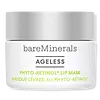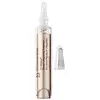What's inside
What's inside
 Key Ingredients
Key Ingredients

 Benefits
Benefits

 Concerns
Concerns

 Ingredients Side-by-side
Ingredients Side-by-side

Ricinus Communis Seed Oil
MaskingBis-Behenyl/Isostearyl/Phytosteryl Dimer Dilinoleyl Dimer Dilinoleate
EmollientButyrospermum Parkii Butter
Skin ConditioningSqualane
EmollientBis-Diglyceryl Polyacyladipate-2
EmollientC18-38 Alkyl Hydroxystearoyl Stearate
EmollientPolyhydroxystearic Acid
EmulsifyingHelianthus Annuus Seed Wax
Skin ConditioningHydrogenated Castor Oil
EmollientPolyglyceryl-3 Diisostearate
EmulsifyingPalmitoyl Tripeptide-1
Skin ConditioningBidens Pilosa Extract
HumectantCarica Papaya Fruit Extract
Skin ConditioningSodium Hyaluronate
HumectantCitrus Limon Peel Oil
MaskingGossypium Herbaceum Seed Oil
Skin ConditioningEthylene/Propylene/Styrene Copolymer
Butylene/Ethylene/Styrene Copolymer
Pentaerythrityl Tetra-Di-T-Butyl Hydroxyhydrocinnamate
AntioxidantTocopherol
AntioxidantTocopheryl Acetate
AntioxidantEthylhexyl Palmitate
EmollientTribehenin
EmollientSorbitan Isostearate
EmulsifyingWater
Skin ConditioningLactic Acid
BufferingCaprylyl Glycol
EmollientButylene Glycol
HumectantSilica Dimethyl Silylate
EmollientHexylene Glycol
EmulsifyingGlycerin
HumectantCitral
PerfumingLimonene
PerfumingPhenoxyethanol
PreservativeRicinus Communis Seed Oil, Bis-Behenyl/Isostearyl/Phytosteryl Dimer Dilinoleyl Dimer Dilinoleate, Butyrospermum Parkii Butter, Squalane, Bis-Diglyceryl Polyacyladipate-2, C18-38 Alkyl Hydroxystearoyl Stearate, Polyhydroxystearic Acid, Helianthus Annuus Seed Wax, Hydrogenated Castor Oil, Polyglyceryl-3 Diisostearate, Palmitoyl Tripeptide-1, Bidens Pilosa Extract, Carica Papaya Fruit Extract, Sodium Hyaluronate, Citrus Limon Peel Oil, Gossypium Herbaceum Seed Oil, Ethylene/Propylene/Styrene Copolymer, Butylene/Ethylene/Styrene Copolymer, Pentaerythrityl Tetra-Di-T-Butyl Hydroxyhydrocinnamate, Tocopherol, Tocopheryl Acetate, Ethylhexyl Palmitate, Tribehenin, Sorbitan Isostearate, Water, Lactic Acid, Caprylyl Glycol, Butylene Glycol, Silica Dimethyl Silylate, Hexylene Glycol, Glycerin, Citral, Limonene, Phenoxyethanol
Hydrogenated Polyisobutene
EmollientJojoba Esters
EmollientCocos Nucifera Oil
MaskingSqualane
EmollientCopernicia Cerifera Wax
Ethylene/Propylene/Styrene Copolymer
Benzyl Nicotinate
Skin ConditioningEctoin
Skin ConditioningSodium Hyaluronate
HumectantHydrolyzed Sodium Hyaluronate
Skin ConditioningPalmitoyl Tripeptide-38
Skin ConditioningPalmitoyl Tripeptide-1
Skin ConditioningSodium Acetylated Hyaluronate
HumectantPortulaca Pilosa Extract
Skin ConditioningSilybum Marianum Fruit Extract
Skin ConditioningCentella Asiatica Meristem Cell Culture
AntioxidantTrehalose
HumectantBisabolol
MaskingCitrullus Lanatus Fruit Extract
Skin ConditioningPyrus Malus Fruit Extract
Skin ConditioningPersea Gratissima Oil
Skin ConditioningTriisostearin
Skin ConditioningGlycerin
HumectantGlucomannan
Skin ConditioningEthylhexyl Palmitate
EmollientTribehenin
EmollientCetearyl Ethylhexanoate
EmollientSucrose Cocoate
EmulsifyingTrihydroxystearin
Skin ConditioningDimer Dilinoleyl Dimer Dilinoleate
EmollientXanthan Gum
EmulsifyingSorbitan Isostearate
EmulsifyingButylene/Ethylene/Styrene Copolymer
Leuconostoc/Radish Root Ferment Filtrate
AntimicrobialTocopherol
AntioxidantWater
Skin ConditioningLactic Acid
BufferingCitric Acid
BufferingPhenoxyethanol
PreservativeSodium Benzoate
MaskingPotassium Sorbate
PreservativeHydrogenated Polyisobutene, Jojoba Esters, Cocos Nucifera Oil, Squalane, Copernicia Cerifera Wax, Ethylene/Propylene/Styrene Copolymer, Benzyl Nicotinate, Ectoin, Sodium Hyaluronate, Hydrolyzed Sodium Hyaluronate, Palmitoyl Tripeptide-38, Palmitoyl Tripeptide-1, Sodium Acetylated Hyaluronate, Portulaca Pilosa Extract, Silybum Marianum Fruit Extract, Centella Asiatica Meristem Cell Culture, Trehalose, Bisabolol, Citrullus Lanatus Fruit Extract, Pyrus Malus Fruit Extract, Persea Gratissima Oil, Triisostearin, Glycerin, Glucomannan, Ethylhexyl Palmitate, Tribehenin, Cetearyl Ethylhexanoate, Sucrose Cocoate, Trihydroxystearin, Dimer Dilinoleyl Dimer Dilinoleate, Xanthan Gum, Sorbitan Isostearate, Butylene/Ethylene/Styrene Copolymer, Leuconostoc/Radish Root Ferment Filtrate, Tocopherol, Water, Lactic Acid, Citric Acid, Phenoxyethanol, Sodium Benzoate, Potassium Sorbate
Ingredients Explained
These ingredients are found in both products.
Ingredients higher up in an ingredient list are typically present in a larger amount.
We don't have a description for Butylene/Ethylene/Styrene Copolymer yet.
We don't have a description for Ethylene/Propylene/Styrene Copolymer yet.
Ethylhexyl Palmitate, also known as octyl palmitate, is created from 2-ethylhexyl alcohol and palmitic acid. It is a fatty acid ester.
The fatty acid content of Ethylhexyl Palmitate makes it an emollient. Emollients help soften and hydrate your skin by trapping moisture within.
Ethylhexyl Palmitate is also used to help improve the texture of cosmetics. It helps other ingredient dissolve in products and help disperse ingredients more evenly.
You'll likely find this ingredient in sunscreen, as it is often used to mix UV-blocking ingredients such as avobenzone and ethylhexyl triazone.
It can also help stabilize the fragrances in a product as a fragrance fixative.
Ethylhexyl Palmitate can be used to substitute mineral oil.
Due to its high fatty acid content, it may not be fungal-acne safe.
Learn more about Ethylhexyl PalmitateGlycerin is already naturally found in your skin. It helps moisturize and protect your skin.
A study from 2016 found glycerin to be more effective as a humectant than AHAs and hyaluronic acid.
As a humectant, it helps the skin stay hydrated by pulling moisture to your skin. The low molecular weight of glycerin allows it to pull moisture into the deeper layers of your skin.
Hydrated skin improves your skin barrier; Your skin barrier helps protect against irritants and bacteria.
Glycerin has also been found to have antimicrobial and antiviral properties. Due to these properties, glycerin is often used in wound and burn treatments.
In cosmetics, glycerin is usually derived from plants such as soybean or palm. However, it can also be sourced from animals, such as tallow or animal fat.
This ingredient is organic, colorless, odorless, and non-toxic.
Glycerin is the name for this ingredient in American English. British English uses Glycerol/Glycerine.
Learn more about GlycerinLactic Acid is another well-loved alpha hydroxy acid (AHA). It is gentler than glycolic acid but still highly effective.
Its main role is to exfoliate the surface of the skin by loosening the “glue” that holds dead skin cells together. Shedding those old cells leads to smoother, softer, and more even-toned skin.
Because lactic acid molecules are larger than glycolic acid, they don’t penetrate as deeply. This means they’re less likely to sting or irritate, making it a great choice for beginners or those with sensitive skin.
Like glycolic acid, it can:
Lactic acid also acts as a humectant (like hyaluronic acid). It can draw water into the skin to improve hydration and also plays a role in the skin's natural moisturizing factor (NMF) in the form of sodium lactate.
Studies show it can boost ceramide production to strengthen the skin barrier and even help balance the skin’s microbiome.
To get results, choose products with a pH between 3-4.
Lower strengths (5-12%) focus on surface exfoliation; higher strengths (12% and up) can reach deeper in the dermis (deeper, supportive layer) to improve skin texture and firmness over time.
Though it was originally derived from milk, most modern lactic acid used in skincare is vegan. It is made through non-dairy fermentation to create a bio-identical and stable form suitable for all formulations.
When lactic acid shows up near the end of an ingredient list, it usually means the brand added just a tiny amount to adjust the product’s pH.
Legend has it that Cleopatra used to bathe in sour milk to help reduce wrinkles.
Lactic acid is truly a gentle multitasker: it exfoliates, hydrates, strengthens, and brightens. It's a great ingredient for giving your skin a smooth, glowing, and healthy look without the harshness of stronger acids.
Read more about some other popular AHA's here:
Learn more about Lactic AcidPalmitoyl Tripeptide-1 is also known as pal-GHK. It is made up of 3 amino acids and palmitic acid, a fatty acid that helps it absorb into skin more easily.
This peptide is as a signal peptide, meaning it tells the skin to produce more collagen. Collagen is the key protein that helps form the skin's structure and keep it plump, firm, and hydrated.
By boosting collagen production, this ingredient supports a stronger skin barrier and helps reduce the appearance of wrinkles.
You'll most likely see this ingredient paired with Palmitoyl Tetrapeptide-7 in the well-known Matrixyl 3000 complex. While results from in-house testing should be viewed cautiously, this peptide duo is among the most studied and widely used in modern skincare.
Due to its palmitic acid base, this ingredient may not be safe for Malassezia folliculitis.
Read more about other common types of peptides here:
Learn more about Palmitoyl Tripeptide-1Phenoxyethanol is a preservative that has germicide, antimicrobial, and aromatic properties. Studies show that phenoxyethanol can prevent microbial growth. By itself, it has a scent that is similar to that of a rose.
It's often used in formulations along with Caprylyl Glycol to preserve the shelf life of products.
Sodium Hyaluronate is hyaluronic acid's salt form. It is commonly derived from the sodium salt of hyaluronic acid.
Like hyaluronic acid, it is great at holding water and acts as a humectant. This makes it a great skin hydrating ingredient.
Sodium Hyaluronate is naturally occurring in our bodies and is mostly found in eye fluid and joints.
These are some other common types of Hyaluronic Acid:
Learn more about Sodium HyaluronateSorbitan Isostearate is an emulsifer and cleaning agent. It is created from isostearic acid and sorbitol.
As an emulsifier, Sorbitan Isostearate prevents oils and water from separating.
Due to its isostearic acid base, it may not be safe for Malassezia or fungal acne.
Learn more about Sorbitan IsostearateSqualane is an emollient that helps the skin hold onto moisture. It's an oily liquid that occurs naturally in certain types of fish and plant oils.
Because squalane boosts hydration in the skin, it also comes with plenty of benefits: it is an antioxidant and can help fight free radicals and skin damage. Squalane is also found to have a detoxifying effect when applied.
Squalane comes from squalene, which occurs naturally within the sebum of our skin. It is one of the oils our skin produces to keep itself hydrated. Squalane is the hydrogenated version of squalene and has a longer shelf life.
Research shows that squalane is non-irritating (even at 100% concentration).
In general, it's a fantastic ingredient. It does a great job at hydrating the skin, and it's suitable for those with sensitive skin.
The source of squalane may impact malassezia / fungal acne. This is because olive oil derived squalane can contain impurities such as fatty acids and plant waxes. Sugarcane derived squalane is recommended for anyone with malassezia concerns.
Is squalane vegan?
This depends on the source. Squalane can be derived from both plants and animals. Most squalane used in skincare comes from plants.
Please note: the source of squalane is only known if disclosed by the brand. We recommend reaching out to the brand if you have any questions about their squalane.
Read more about squalene with an "e".
Is squalane an oil?
Squalane is often called an oil, but it’s technically not; it’s a hydrocarbon, meaning it’s only made of carbon and hydrogen, unlike true oils which are triglycerides made of fatty acids and glycerol.
The term “oil-free” isn’t regulated, so companies can define it however they want. Some exclude all oils, while others just avoid mineral oil or comedogenic oils.
While some people avoid oils thinking they cause breakouts, the right kind of oil (or oil-like ingredient like squalane) can actually help balance and hydrate your skin. It’s worth testing out simple oils or squalane to see what works best for your skin.
Learn more about SqualaneTocopherol (also known as Vitamin E) is a common antioxidant used to help protect the skin from free-radicals and strengthen the skin barrier. It's also fat soluble - this means our skin is great at absorbing it.
Vitamin E also helps keep your natural skin lipids healthy. Your lipid skin barrier naturally consists of lipids, ceramides, and fatty acids. Vitamin E offers extra protection for your skin’s lipid barrier, keeping your skin healthy and nourished.
Another benefit is a bit of UV protection. Vitamin E helps reduce the damage caused by UVB rays. (It should not replace your sunscreen). Combining it with Vitamin C can decrease sunburned cells and hyperpigmentation after UV exposure.
You might have noticed Vitamin E + C often paired together. This is because it is great at stabilizing Vitamin C. Using the two together helps increase the effectiveness of both ingredients.
There are often claims that Vitamin E can reduce/prevent scarring, but these claims haven't been confirmed by scientific research.
Learn more about TocopherolTribehenin comes from glycerin and behenic acid.
It is used as an emollient, or moisturizer. Emollients form a thin barrier on skin to prevent moisture from escaping.
This ingredient may not be Malassezia folliculitis, or fungal-acne safe.
Learn more about TribeheninWater. It's the most common cosmetic ingredient of all. You'll usually see it at the top of ingredient lists, meaning that it makes up the largest part of the product.
So why is it so popular? Water most often acts as a solvent - this means that it helps dissolve other ingredients into the formulation.
You'll also recognize water as that liquid we all need to stay alive. If you see this, drink a glass of water. Stay hydrated!
Learn more about Water